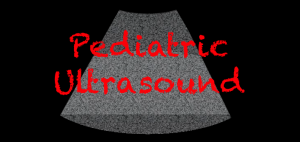Ultrasound: groin swelling evaluation
Posted on: November 25, 2014, by : Rosemary Thomas-Mohtat MD
by Rosemary Thomas-Mohtat, Children’s National
At 2am, Tuesday morning:
Patient is 2 month old male ex 31 week preemie, who presented with fussiness and vomiting. Baby has been crying inconsolably for the last 1hour. Mom noted a persistent swelling in the right groin for the last hour. This swelling used to be able to be reduced, but not tonight. He usually has spit ups but tonight it’s more. No fever. No other complaints. Plan was to have hernia repaired electively in a few months when patient was bigger.
PMx: Uncomplicated NICU course.
Vitals: T: 37.0 HR: 174 R:50 BP: 109/72
Gen: Crying inconsolably.
GU: Testes descended and palpable in scrotum bilaterally. Right sided inguinal hernia present, firm, non-reducible, immobile mass, tender to palpation. Uncircumcised penis.
Bedside Ultrasound (US) findings (Superficial probe):
Evident bowel loops in right hemiscrotum with visible peristalsis.
Plan: The patient failed manual reduction in the ER. Surgery team was mobilized post US findings confirming physical exam. Patient went to the operating room (OR) that night and was out of the OR by 6am.
Discussion: This was a case of expedient diagnosis of an incarcerated hernia, with US supporting the physical exam. The presence of visible peristalsis on US can help differentiate strangulated versus incarcerated inguinal hernia, which may impact immediate management (1). The criteria for early strangulation includes: 1) the presence of an akinetic dilated loop (watching for 5mins), 2) the presence of peristaltic activity in dilated small bowel proximal to the akinetic loop, and 3) rapid accumulation of peritoneal fluid after the onset of obstruction (2). If there is evidence of strangulated bowel without peristalsis, one may want to avoid manual reduction at the bedside to avoid introducing dead bowel into the peritoneum.
- Blaivas M. Ultrasound-guided reduction of a Spigelian hernia in a difficult case: an unusual use of bedside emergency ultrasonography. Am J Emerg Med 2002;20(1):59-61.
- Ogata M, Mateer JR,Condon RE. Prospective evaluation of abdominal sonography for the diagnosis of bowel obstruction. Ann Surg 1996;223(3):237-41.
